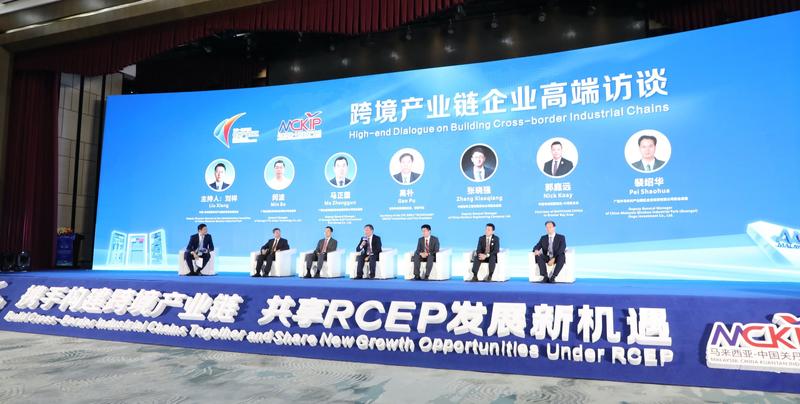 Xu Xianhui, vice-governor of the Guangxi Zhuang autonomous region, speaks at the Forum on Further Development of China-Malaysia “two countries, twin parks” in Nanning on Sept 17, 2022. (PROVIDED TO CHINA DAILY)
Xu Xianhui, vice-governor of the Guangxi Zhuang autonomous region, speaks at the Forum on Further Development of China-Malaysia “two countries, twin parks” in Nanning on Sept 17, 2022. (PROVIDED TO CHINA DAILY)
China and Malaysia upgraded their cooperation for an industrial park project on Sept 17 as the two sides eye more opportunities with full implementation of the Regional Comprehensive Economic Partnership.
As the “two countries, twin parks” project between China and Malaysia enters its tenth year, Lim Ban Hong, deputy minister of international trade and industry of Malaysia, said he believes the RCEP can bring new opportunities, partners and industries to further accelerate the project’s development and explore cooperation beyond Southeast Asia.
As the “two countries, twin parks” project between China and Malaysia enters its tenth year, Lim Ban Hong, deputy minister of international trade and industry of Malaysia, said he believes the RCEP can bring new opportunities, partners and industries to further accelerate the project’s development and explore cooperation beyond Southeast Asia
ALSO READ: M'sia highlights economic, high-tech cooperation with China
The “two countries, twin parks” is a flagship project of national-level investment cooperation and key project under the Belt and Road Initiative. The China-Malaysia Qinzhou Industrial Park in Guangxi was launched in 2012 and the Malaysia-China Kuantan Industrial Park was launched a year later in the Southeast Asian country.
Speaking at the Forum on Further Development of China-Malaysia “Two Countries, Twin Parks”, Lim said the economic and trade relations between China and Malaysia remained stable, with China being Malaysia’s biggest trading partner since 2009 and accounting for 18.9 percent of the latter’s total trade in 2021. The bilateral trade volume to exceed US$190 billion this year, he said.
Under the theme Building Cross-Border Industrial Chains Together and Share New Growth Opportunities under RCEP, the forum invited officials and business leaders to discuss key topics on China-Malaysia cooperation, including upgrading the industrial park cooperation, advancing version 3.0 of the China- ASEAN Free Trade Area, and promoting free and convenient trade and investment.
The forum was held on the sidelines of the 19th China-ASEAN Expo in Nanning, South China’s Guangxi Zhuang autonomous region.
ALSO READ: Experts: China-ASEAN Expo to create opportunities for growth
Lim said China is Malaysia’s biggest source of foreign direct investment and Malaysia welcomes more high-quality companies from China to invest in Malaysia. He also said he hopes the two sides can jointly make the “two countries, twin parks” project a model for international cooperation.
“The ‘two countries, twin parks’ is poised to tap on vast opportunities the RCEP can offer by forming complete industry supply chain between Malaysia and China through the twin parks, and connected via the sister ports of Kuantan Port and Qinnzhou Port,” said Baidzawi Che Mat, CEO of the East Coast Economic Region Development Council of Malaysia, where the Kuantan industrial park is located.
Baidzawi said the Malaysia-China Kuantan Industrial Park has attracted a total of about 30 billion ringgit ($6.31 billion) of committed investments. The East Coast Rail Link, which is expected to be fully operational by 2027, will also be a game changer in enabling efficient transport of people and goods, he said.
 Lim Ban Hong, deputy minister of international trade and industry of Malaysia, delivers a video speech at the Forum on Further Development of China-Malaysia “two countries, twin parks” in Nanning, Guangxi Zhuang autonomous region, on Sept 17, 2022. (PROVIDED TO CHINA DAILY)
Lim Ban Hong, deputy minister of international trade and industry of Malaysia, delivers a video speech at the Forum on Further Development of China-Malaysia “two countries, twin parks” in Nanning, Guangxi Zhuang autonomous region, on Sept 17, 2022. (PROVIDED TO CHINA DAILY)
Xu Xianhui, vice-governor of the Guangxi government, said the region, driven by the construction of the new western land-sea corridor, is working to contribute to the joint building of the BRI and the China-ASEAN community with a shared future, as well as deepening the cooperation with members of the RCEP and the Association of Southeast Asian Nations.
China’s National Development and Reform Commission unveiled a plan in 2019 to promote the high-quality development of the new western land-sea corridor, which aims to build an economical, efficient, convenient, green and safe land-sea corridor for the western region by 2025.
Among the ten ASEAN countries, Malaysia is the third-largest trading partner of Guangxi and the biggest investment destination for Guangxi companies, Xu said, noting the investment of signed projects in the Qinzhou park exceeded 190 billion yuan (US$27.21 billion) by the end of 2021.
Wu Xuefeng, commissioner of the Special Office of the Chinese Ministry of Commerce in Nanning, said China is willing to work with Malaysia to promote the update and development of the “two countries, twin parks” project under the backdrop of the China-ASEAN comprehensive strategic partnership and the RCEP.
READ MORE: China, Malaysia agree to expand, strengthen key BRI projects
Responding to media questions, Azlimi Zakaria, the consul-general of Malaysia in Nanning, said the twin parks initiative has provided jobs and business opportunities for locals in retail, port-related services, and commerce.
“Both parks should continue to evolve and be more integrated,” said Azlimi, adding the they can simplify the recognition procedures of products and focus more on developing infrastructure and logistics to enhance connectivity, warehouse management and cross-border capacity.
 Business leaders from China and Malaysia exchange their views on building cross-border industrial chains at the Forum on Further Development of China-Malaysia “two countries, twin parks” in Nanning, Guangxi Zhuang autonomous region, on Sept 17, 2022. (PROVIDED TO CHINA DAILY)
Business leaders from China and Malaysia exchange their views on building cross-border industrial chains at the Forum on Further Development of China-Malaysia “two countries, twin parks” in Nanning, Guangxi Zhuang autonomous region, on Sept 17, 2022. (PROVIDED TO CHINA DAILY)


